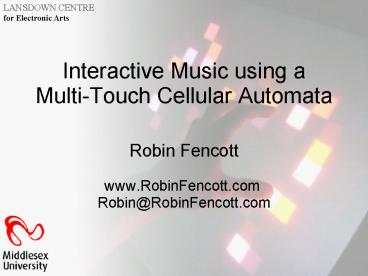Interactive Music using a MultiTouch Cellular Automata - PowerPoint PPT Presentation
1 / 22
Title: Interactive Music using a MultiTouch Cellular Automata
1
Interactive Music using aMulti-Touch Cellular
Automata
LANSDOWN CENTRE for Electronic Arts
- Robin Fencott
- www.RobinFencott.com
- Robin_at_RobinFencott.com
2
(No Transcript)
3
Multi-Touch Screens
- A Multi-Touch Screen is a touch screen that can
register one or more points of simultaneous
physical contact. - Intuitive and direct. No physical controls (e.g.
stylus, puck). - Multi-Touch screens are excellent tools for the
manipulation of visual information. - Building a Multi-Touch Screen is a well
documented process. - An active field of research in academic,
commercial and hobby/DIY domains.
4
Multi-Touch Screens
- This project uses the Frustrated Total Internal
Reflection approach (FTIR). - A sheet of acrylic is illuminated along its
edges by infra-red LEDs. The light is trapped by
Total Internal Reflection. - When a fingertip touches the acrylic the trapped
light can escape. - A camera can see this light as a blob. A blob
tracking program can monitor the position of
touch points over time. - We can use a standard video projector to display
an image back onto the touch surface.
5
Version 1.0
- Built from wood and scrap materials.
- Obsolete or salvaged equipment.
- Electrical components are standard.
6
Project Goals
- Intuitive and accessible.
- Encourage creative and playful engagement.
- Abstract, both visually and sonically.
- Musical, but not an instrument, tool or
environment.
7
(No Transcript)
8
(No Transcript)
9
(No Transcript)
10
(No Transcript)
11
(No Transcript)
12
(No Transcript)
13
(No Transcript)
14
Cellular Automata
- Cellular Automata (CA) are systems where time and
space are measured in discrete steps. - The values of a CA are stored in cells arranged
in one or more dimensions (e.g. a two-dimensional
grid). - As time progresses the cells are simultaneously
updated according to a pre-defined set of rules. - For example in Conways Life each cell is
either dead or alive. The value of the cell is
determined by the values of its neighbours. - CA can exhibit emergent behaviour - a simple set
of rules can produce a complex outcome.
15
Interactive Cellular Automata
- Adjacent cells begin to interact with each other
creating localised activity around the
participants points of touch. - The Cellular Automata gives the work an active
and responsive feel, rather than being passive. - Criteria for the CA
- Must not erupt or seem totally random.
- Activity is localised.
- Cells must decay over time and eventually die
out.
16
Mapping
- Direct and (hopefully) perceivable. This is in
line with the objective of approachability. - Each cell is given a colour. Initially all cells
are orange or pink, however greens and yellows
are introduced over time. - Each cell is given a musical note, which is not
related to the xy position. - Instead, notes are picked at random from a small
musical scale. This means a non-musician can
still make nice music.
17
Mapping
- Different colour groups get different synthetic
timbres and individual cells get slight
variations on these timbres. - Spatial position is aligned with the horizontal
screen location. - Gliding gestures cause pitch bending.
18
Sessions
- The grid is randomised at the start of the
program. - The software notes when the screen is in use and
gradually adds variations, e.g. replacing cells,
introducing new sonic and visual colours etc. - Once the system has been inactive for a short
time the system is reset to a new random state. - The temporal thresholds are also randomised with
each session.
19
Audience Reception
- Participants grasp the nature of the interaction
and appreciate the correlation between colours
and timbres. - The work appeals to people of all ages.
- Participants often spend at least a minute
interacting with the work. - People are inquisitive and want to know how it
works. - People usually approach the piece as a toy,
although occasionally I am expected to play a
tune.
20
(No Transcript)
21
(No Transcript)
22
Thank you
LANSDOWN CENTRE for Electronic Arts
Robin Fencott www.RobinFencott.com Robin_at_RobinFenc
ott
- This appearance was funded by the
- Lansdown Centre for Electronic Arts,
- Middlesex University, London.































